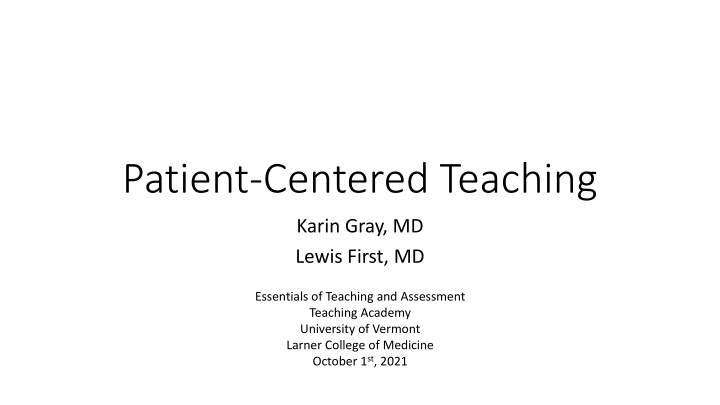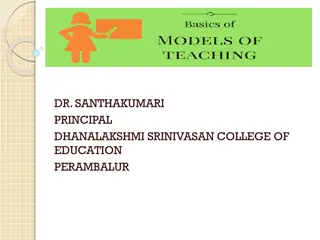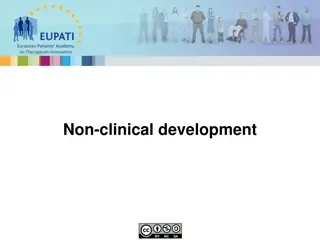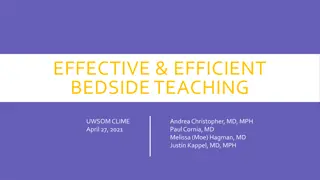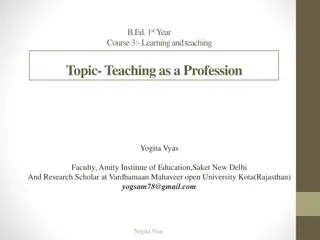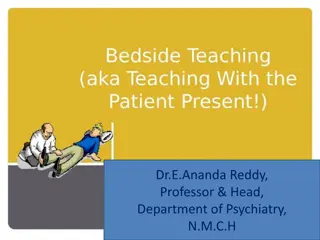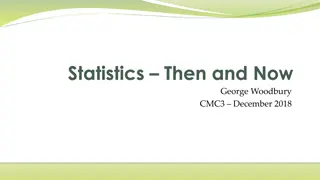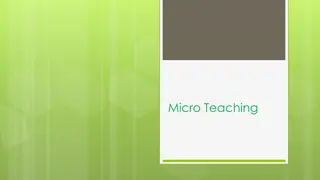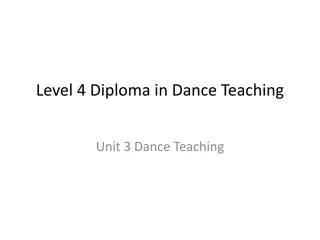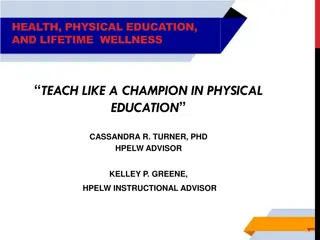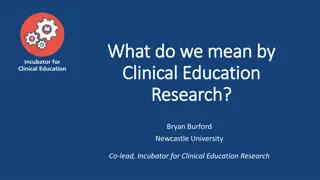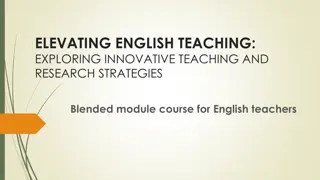Effective Clinical Teaching Techniques and Strategies
Explore the essentials of patient-centered teaching with a focus on orientation, feedback, and engaging Day One activities. Discover ways to enhance teaching effectiveness, personalize discussions, and optimize trainee interactions for a successful learning experience.
Download Presentation

Please find below an Image/Link to download the presentation.
The content on the website is provided AS IS for your information and personal use only. It may not be sold, licensed, or shared on other websites without obtaining consent from the author.If you encounter any issues during the download, it is possible that the publisher has removed the file from their server.
You are allowed to download the files provided on this website for personal or commercial use, subject to the condition that they are used lawfully. All files are the property of their respective owners.
The content on the website is provided AS IS for your information and personal use only. It may not be sold, licensed, or shared on other websites without obtaining consent from the author.
E N D
Presentation Transcript
Patient-Centered Teaching Karin Gray, MD Lewis First, MD Essentials of Teaching and Assessment Teaching Academy University of Vermont Larner College of Medicine October 1st, 2021
Objectives Discuss the importance of orientation for the learner. Review techniques for effective and efficient clinical teaching. Review ways to give feedback, pointing out the difference between evaluation and feedback
To Get Started Let s come up with some Good to Great questions! Image result for good to great
The Day One Make It or Break It Exercise
Usual Topics for Day One Who is the student? What do they want to get out of the class? Are they interested in pediatrics? What have they done thus far to prepare them for the clerkship or elective?
Other Things to Think About To Make Day One Even More Effective Sit down to orient Use student or resident name to personalize the discussion Let the office (and if possible inpatient) staff know in advance that trainee(s) will be starting Think about how Day One can help you!
How Day One Can Help You How do you like to teach and when? Consider the teaching notebook if teaching to different levels or needing to be efficient Who else will be sharing the teaching with you? How can you be a nominee for teacher of the year? (the one question that pays off)! When will you give feedback?
Toolbox for Clinical Teaching You re Both in the Hotseat
Toolbox for Clinical Teaching Initial Pt Encounter Activated demonstration Timed history Activated interview Blank slate Rounds Theme of the day Clinical question/article answer Discharge rounds Bedside teaching/physical findings scavenger hunt Patient narrative Debriefing the Encounter Full presentation vs Pertinents Are you worried about One Minute Preceptor SNAPPS
Toolbox for Clinical Teaching Initial Pt Encounter Activated demonstration Timed history Activated interview Blank Slate Rounds Theme of the day Clinical question/article answer Discharge rounds Bedside teaching/physical findings scavenger hunt Patient narrative Debriefing the Encounter Full presentation vs Pertinents Are you worried about One Minute Preceptor SNAPPS
Activated Demonstration Best suited to High-intensity or fast-paced encounter Need for speed Prep learner with a specific task Observational role for learner
Timed History Best suited to Efficiency needed (regardless of learner s level) Can provide for direct observation Prep the learner Give the learner 5 minutes to take a history Warn families of the take over
Activated Interview Best suited to Moderate available time Must have at least a little prep time New or low-medical-knowledge learners Prep the learner with the chief complaint AND Discuss key questions in advance May be either solo or observed
Blank Slate Best suited to Plenty of time Strong learner Without complex past history Preceptor shares only chief complaint in advance Prep/warn the family Of course you can eyeball the pt
Toolbox for Clinical Teaching Initial Pt Encounter Activated demonstration Timed history Activated interview Blank slate Rounds Theme of the day Clinical question/article answer Discharge rounds Bedside teaching/physical findings scavenger hunt Patient narrative Debriefing the Encounter Full presentation vs Pertinents Are you worried about One Minute Preceptor SNAPPS
Presentation of Patient Full Presentation Adequate time Early learner Focus on the presentation What Are You Worried About? If presentation is brief OR if presentation was observed Illness Scripts: Compare/contrast patient characteristics and disease presentation Most likely vs Not want to miss Elicit (or articulate) subconscious decision-making Focus on diagnosis/reasoning OR next steps for management Pertinent Presentation Just what s relevant Reveals learner s thought process Focus on the diagnosis
One Minute Preceptor A five-step "microskills" model of clinical teaching Get a commitment Probe for supporting evidence Teach general rules Reinforce what was done well Correct errors
SNAPPS Learner-centered model for Outpatient Education 1. Summarize Hx and PE 2. Narrow the differential to 2-3 most relevant 3. Analyze the differential (compare/contrast) 4. Probe the preceptor 5. Plan the management 6. Select a case-related issue for self-directed learning
Toolbox for Clinical Teaching Initial Pt Encounter Activated demonstration Timed history Activated interview Blank slate Rounds Theme of the day Clinical question/article answer Discharge rounds Bedside teaching/physical findings scavenger hunt Patient narrative Debriefing the Encounter Full presentation vs Pertinents Are you worried about One Minute Preceptor SNAPPS
Theme of the Day Suitable for single or multiple learners seeing multiple patients together Brief group prep decide on a topic Cardiac or respiratory exams HEADSS questions Presenting vital signs
Clinical Question/Article Answer Requires advance notification for learners, + time Loved by residents! Identify a clinical question Brief (really brief) synopsis: Is this the same pt population? What did they do? How does this impact our patient/answer our question? Collate the articles (tech?)
Requirements for Discharge (although, obvi, should be a component daily) Be Specific! May consider subheadings Medical requirements/when are we sure pt is improving Technology/DME/case management requirements Education/social situation requirements Next step: when do you think this will happen (estimate a date)
Bedside Teaching (post rounds) Physical findings Consent from patient/parent Adequate time for each learner s attempt, ideal to have a discussion and re- examination Educated patient/parent teaching learners
Patient Narrative (Post Rounds) Open-ended questions, psychosocial focus How has this affected your daily life? What is something that someone did well/did poorly early in your care? What led to your diagnosis?
Breakout Session What fits best with your clinical setting? Your teaching style? What one thing will you try after this session? When and how will you implement this change?
